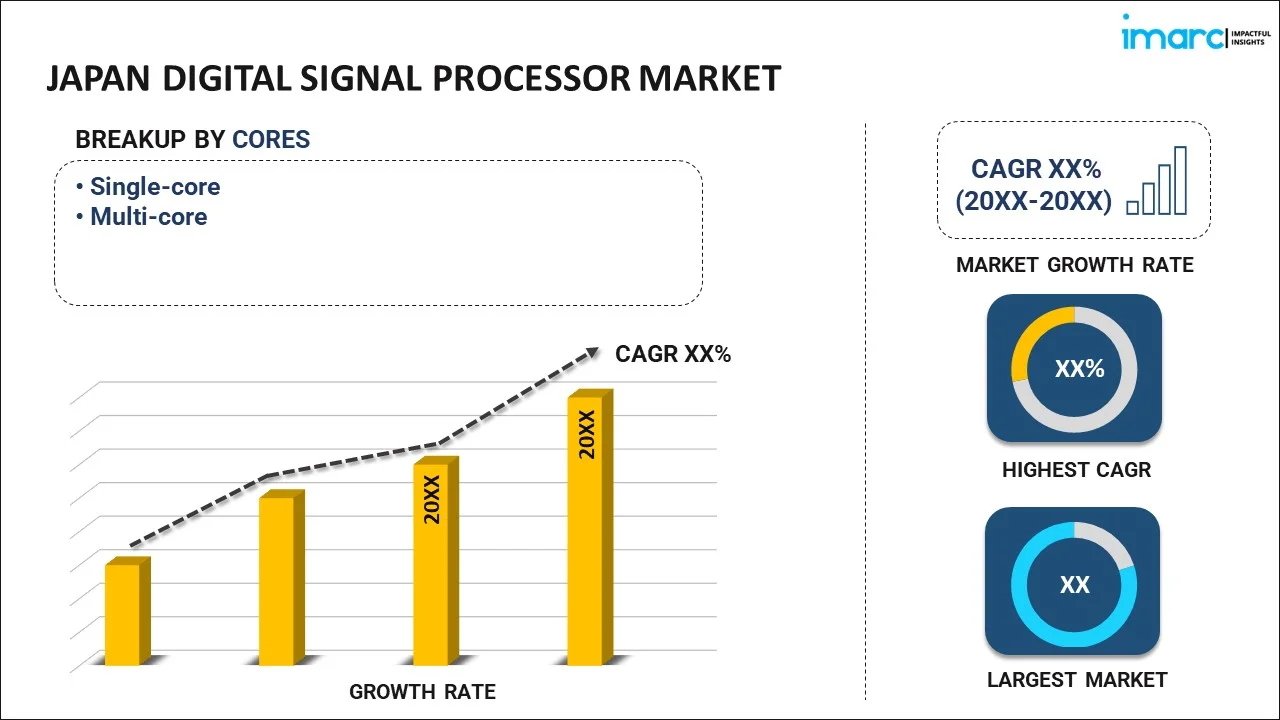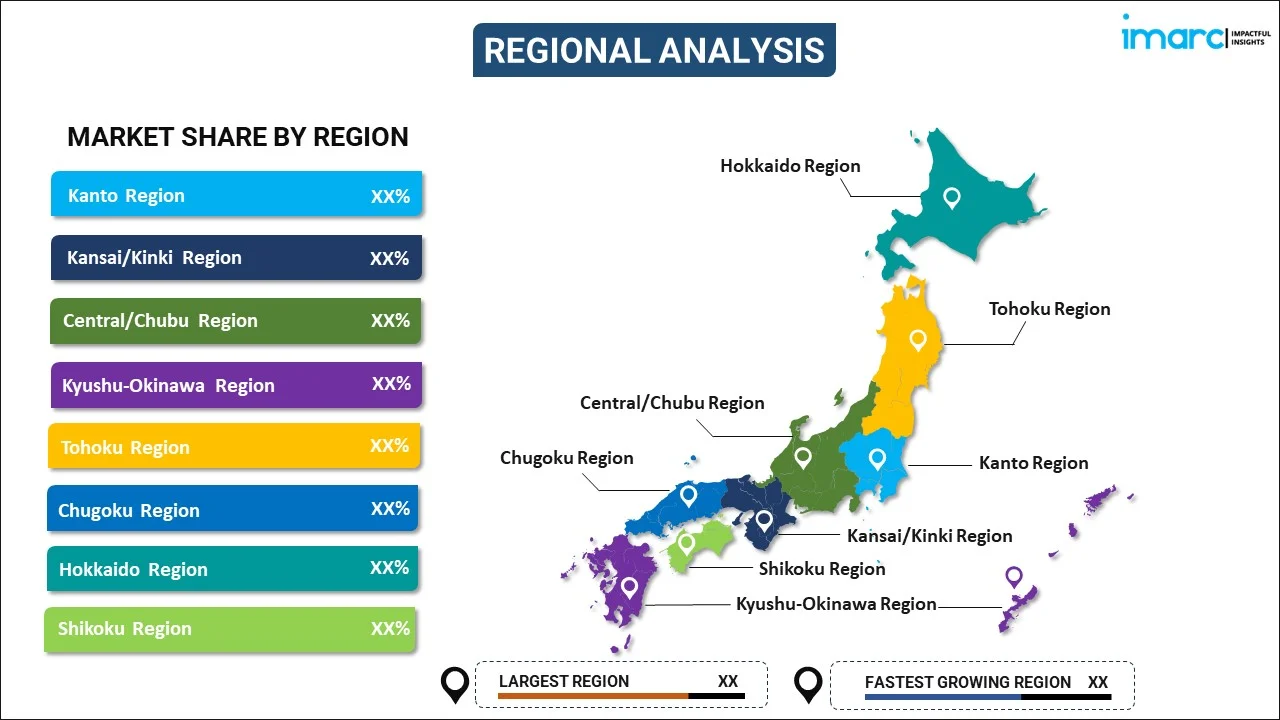
Japan Digital Signal Processor Market Report by Core (Single-core, Multi-core), End Use Industry (Communication, Automotive, Consumer Electronics, Industrial, Aerospace and Defense, Healthcare), and Region 2026-2034
Market Overview:
Japan digital signal processor market size reached USD 632.5 Million in 2025. Looking forward, IMARC Group expects the market to reach USD 1,033.4 Million by 2034, exhibiting a growth rate (CAGR) of 5.61% during 2026-2034. The emergence of novel applications, such as voice recognition, biometrics, and multimedia systems, along with extensive research and development activities, is primarily driving the market growth.
|
Report Attribute
|
Key Statistics
|
|---|---|
|
Base Year
|
2025 |
|
Forecast Years
|
2026-2034
|
|
Historical Years
|
2020-2025
|
| Market Size in 2025 | USD 632.5 Million |
| Market Forecast in 2034 | USD 1,033.4 Million |
| Market Growth Rate (2026-2034) | 5.61% |
A digital signal processor (DSP) stands as a specialized microprocessor with an architecture optimized for the operational needs of digital signal processing. Signal processing is essential in a myriad of technological applications, primarily where analog signals, like audio, video, temperature, pressure, or position, need to be converted into digital form and manipulated. A digital signal processor is intricate components found in various systems, such as mobile phones, audio equipment, and medical imaging devices, facilitating real-time signal processing tasks like compression, audio enhancement, and analysis. The advanced architecture of this microprocessor, characterized by high throughput, allows rapid data processing and modifications, making them indispensable in modern technology. In the constantly evolving tech landscape, DSPs continue to undergo advancements, with a focus on enhancing speed and efficiency, catering to the escalating demands for high-performance computing in signal processing applications.
Japan Digital Signal Processor Market Trends:
The Japan digital signal processor market is undergoing significant expansion, fueled by the country’s strong emphasis on technological advancements and innovation. The market is witnessing a surge in demand particularly for high-efficiency digital signal processors which are integral in promoting energy conservation and reducing overall operational costs, reflecting the broader global trend towards eco-friendly technology solutions. In this highly competitive landscape, market leaders and emerging players are aggressively investing in research and development initiatives aimed at unveiling cutting-edge digital signal processors that align with the evolving needs and preferences of consumers and industries alike. The market’s trajectory is further influenced by the progressive integration of emerging technologies such as voice recognition systems, multimedia applications, and biometric solutions. Furthermore, the adoption of digital signal processors in Japan is being spurred by the enhancement of performance, reliability, and functionality of digital electronics and the growing trend towards the Internet of Things (IoT). The acceleration in the digitization of various industrial processes is also playing a crucial role in shaping market trends and opening new avenues for the deployment of DSPs in Japan. As the nation continues to pioneer technological advancements, the digital signal processor market in Japan is poised for substantial growth, propelled by continual innovations, diversified application areas, and the rising inclination towards sustainable and advanced technological solutions.
Japan Digital Signal Processor Market Segmentation:
IMARC Group provides an analysis of the key trends in each segment of the market, along with forecasts at the country level for 2026-2034. Our report has categorized the market based on core and end use industry.
Core Insights:

- Single-core
- Multi-core
The report has provided a detailed breakup and analysis of the market based on the core. This includes single-core and multi-core.
End Use Industry Insights:
- Communication
- Automotive
- Consumer Electronics
- Industrial
- Aerospace and Defense
- Healthcare
A detailed breakup and analysis of the market based on the end use industry have also been provided in the report. This includes communication, automotive, consumer electronics, industrial, aerospace and defense, and healthcare.
Regional Insights:

- Kanto Region
- Kansai/Kinki Region
- Central/ Chubu Region
- Kyushu-Okinawa Region
- Tohoku Region
- Chugoku Region
- Hokkaido Region
- Shikoku Region
The report has also provided a comprehensive analysis of all the major regional markets, which include Kanto Region, Kansai/Kinki Region, Central/ Chubu Region, Kyushu-Okinawa Region, Tohoku Region, Chugoku Region, Hokkaido Region, and Shikoku Region.
Competitive Landscape:
The market research report has also provided a comprehensive analysis of the competitive landscape in the market. Competitive analysis such as market structure, key player positioning, top winning strategies, competitive dashboard, and company evaluation quadrant has been covered in the report. Also, detailed profiles of all major companies have been provided.
Japan Digital Signal Processor Market Report Coverage:
| Report Features | Details |
|---|---|
| Base Year of the Analysis | 2025 |
| Historical Period | 2020-2025 |
| Forecast Period | 2026-2034 |
| Units | Million USD |
| Scope of the Report | Exploration of Historical and Forecast Trends, Industry Catalysts and Challenges, Segment-Wise Historical and Predictive Market Assessment:
|
| Cores Covered | Single-core, Multi-core |
| End Use Industries Covered | Communication, Automotive, Consumer Electronics, Industrial, Aerospace and Defense, Healthcare |
| Regions Covered | Kanto Region, Kansai/Kinki Region, Central/ Chubu Region, Kyushu-Okinawa Region, Tohoku Region, Chugoku Region, Hokkaido Region, Shikoku Region |
| Customization Scope | 10% Free Customization |
| Post-Sale Analyst Support | 10-12 Weeks |
| Delivery Format | PDF and Excel through Email (We can also provide the editable version of the report in PPT/Word format on special request) |
Key Questions Answered in This Report:
- How has the Japan digital signal processor market performed so far and how will it perform in the coming years?
- What has been the impact of COVID-19 on the Japan digital signal processor market?
- What is the breakup of the Japan digital signal processor market on the basis of core?
- What is the breakup of the Japan digital signal processor market on the basis of end use industry?
- What are the various stages in the value chain of the Japan digital signal processor market?
- What are the key driving factors and challenges in the Japan digital signal processor?
- What is the structure of the Japan digital signal processor market and who are the key players?
- What is the degree of competition in the Japan digital signal processor market?
Key Benefits for Stakeholders:
- IMARC’s industry report offers a comprehensive quantitative analysis of various market segments, historical and current market trends, market forecasts, and dynamics of the Japan digital signal processor market from 2020-2034.
- The research report provides the latest information on the market drivers, challenges, and opportunities in the Japan digital signal processor market.
- Porter's five forces analysis assist stakeholders in assessing the impact of new entrants, competitive rivalry, supplier power, buyer power, and the threat of substitution. It helps stakeholders to analyze the level of competition within the Japan digital signal processor industry and its attractiveness.
- Competitive landscape allows stakeholders to understand their competitive environment and provides an insight into the current positions of key players in the market.
Need more help?
- Speak to our experienced analysts for insights on the current market scenarios.
- Include additional segments and countries to customize the report as per your requirement.
- Gain an unparalleled competitive advantage in your domain by understanding how to utilize the report and positively impacting your operations and revenue.
- For further assistance, please connect with our analysts.
 Request Customization
Request Customization
 Speak to an Analyst
Speak to an Analyst
 Request Brochure
Request Brochure
 Inquire Before Buying
Inquire Before Buying




.webp)




.webp)












